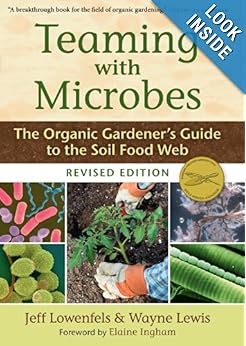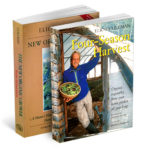Downloads
 Soil Formation and Structure Worksheet
Soil Formation and Structure WorksheetDownload the worksheet for this session. Space has been provided for those who would like to take notes. 🙂
Extra Resources

Teaming with Microbes: The Organic Gardener's Guide to the Soil Food Web, Revised Edition
The 2011 Garden Writers of America Gold Award for Best Writing/Book proves soil is anything but an inert substance. Healthy soil is teeming with life -- not just earthworms and insects, but a staggering multitude of bacteria, fungi, and other microorganisms. When we use chemical fertilizers, we injure the microbial life that sustains healthy plants, and thus become increasingly dependent on an arsenal of artificial substances, many of them toxic to humans as well as other forms of life. But there is an alternative to this vicious circle: to garden in a way that strengthens, rather than destroys, the soil food web -- the complex world of soil-dwelling organisms whose interactions create a nurturing environment for plants. By eschewing jargon and overly technical language, the authors make the benefits of cultivating the soil food web available to a wide audience, from devotees of organic gardening techniques to weekend gardeners who simply want to grow healthy, vigorous plants without resorting to chemicals.
 The Soul of Soil - $25.00 The soil is the soul of the garden. This book provides sensible, focused, and passionate information for creating and preserving healthy soil. A must for all serious gardeners. |
Suggested Reading
 For a deeper look into this module read the following:
For a deeper look into this module read the following:
Four Season Harvest: p. 16-30
The New Organic Grower: p. 82-110
14 Comments
Melody
May 13, 2015For a large commercial garden, such as what you do at Bountiful Blessings Farm, how do you work up the soil in all of your grow beds? You mentioned that rototilling destroys the structure of the soil. So how do you do it? Thanks.
Paul
May 15, 2015Hi Melody,
Thanks for your question! Believe it or not – we prepare much of our beds by hand using the tools and techniques described in the bed preparation lesson.
We actually do now have some attachments for a small walking tractor that we use for a couple steps – but we still loosen the soil by hand with broadforks and for years we did everything by hand. It is work – but it has a beautiful reward.
Now out in our large fields when we grow large crops we will use a tractor and spade up the ground. I believe we talk about that in the same bed preparation lesson. It is a little less hard on the soil then a tiller.
And when it comes down to it – we don’t throw tilling totally out of the window. It can be helpful to help loosen the soil the very first time you make up your bed or if you use it sparingly. I’d just encourage you to do the best you can and keep the negative aspects in mind. Because of these we try to do the least amount of tilling as we can.
Amy Pershin
February 20, 2017Hi Brother Paul! Wow, I’m amazed at all the information you have provided! When did you begin this massive ministry? It’s such a blessing for a new gardener! How do you get large spaces between soil particles? I can kind of understand how to get small spaces, by not letting the soil get compacted. And how do you get half of the spaces filled with air and half with water? If you have answered this somewhere else, I’m so sorry to ask you questions that are a waste of time. I’m trying to avoid doing this, as I see how much information you have provided on here! 🙂
Amy Pershin
February 20, 2017Never mind, I’m sorry! I got my question answered listening to the rest of the video. Next time I’ll write my questions down before I ask you, in case they get answered later in the video, I stopped the video and asked you too soon! Yes, a balance of clay, silt sand and organic matter will give you the balance of large and small spaces between soil particles and probably give you the balance of air and water it needs, right?
Paul
February 21, 2017Hi Amy – no worries at all! I’m glad you got to the answer! And yes – that’s right. The best way to get the balance for any soil is to add consistent organic matter to the soil. Often times it isn’t feasible to add lots of sand or clay to the soil but you should be able to find compost or other sources of organic matter which will dramatically improve your soil structure.
MoNeika
March 22, 2018Watching the M2 Soil presentation and it cancels playing due to file corruption or unsupported feature in presentation. Is there another way to access so I can watch? I am a premium member. Thanks for your help.
Paul
March 23, 2018Hi MoNeika – thank you so much for letting us know! Do you mind telling me where the video is breaking for you? I just tried watching it here and it seems to be playing fine now. It could have been a temporary glitch. Do you mind trying again now? Thanks!
Nick
April 15, 2018Hi Paul, this program is wonderful, but I’m having trouble with some of the videos. This soil one is giving me the same trouble MoNeika was having. I’m getting through it but I’m having to restart it and skip ahead past where it stops on me, and I’ve had to do that several times already before getting halfway through the video. Otherwise, I’m loving this program!
Paul
April 16, 2018Thanks so much for the note Nick. I’ll definitely look into this. Have you had any trouble with any of the other videos or just this one?
Thanks!
Paul
Bill
April 18, 2018Ditto on video problems. In my case not severe but at certain points the video would pixelate and break up a little. The audio was perfect though.
Paul
May 1, 2018Thanks Bill – will definitely check into this!
Anita Munoz
April 19, 2020I’m having problems watching the first video on soil and soil formation. It skips, and stops eradically. I couldn’t finish watching it.
Paul
April 21, 2020Hi Anita! Updated the video. Let me know if it works now!
Ellie Reimer
April 23, 2021I had to right clock and choose open document in another window to be able to open it. This is same for all that I have seen on the recent release of classes.